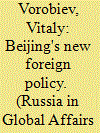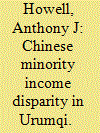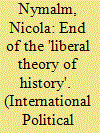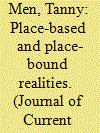| Srl | Item |
| 1 |
ID:
129535


|
|
|
|
|
| Publication |
2014.
|
| Summary/Abstract |
All players expect explanation from China of its initiative to build a New Economic Silk Road. The faster it presents arguments and the clearer they are, the less room there will be for idle speculation and rumor. In any case, China is interested in a favorable response and support for its own foreign policy signals. Chinese leader Xi Jinping first came up with the idea of creating a Silk Road economic space as foreign policy priority for the current, fifth generation of national leaders during a visit in September 2013 to Kazakhstan. In view of the crucial and long-term character of his intention, it is in Russia's interests, as a European and Pacific power and as China's neighbor and long-term bilateral strategic partner, to take a closer look at what content China is putting into this newly conceived project and how the Asian power plans to implement it.
|
|
|
|
|
|
|
|
|
|
|
|
|
|
|
|
| 2 |
ID:
126780


|
|
|
|
|
| Publication |
2013.
|
| Summary/Abstract |
Ethnic tensions between Uyghur and Han Chinese culminated in 2009 with the Urumqi riots, one of the bloodiest conflicts in Xinjiang's modern history, which left more than 200 people dead and another 1,700 injured. Following the 2009 Urumqi Riots, Chinese policy towards Xinjiang underwent a major shift, breaking away from its previous "gradualist" approach to one of economic development. In its place, China implemented policies meant to spur "leapfrog development" in Xinjiang. These new economic policies are likely to bring about rapid growth to the region; however, the question remains whether this growth will be equitably transferred amongst all ethnic groups and regions within Xinjiang.
|
|
|
|
|
|
|
|
|
|
|
|
|
|
|
|
| 3 |
ID:
127055


|
|
|
|
|
| Publication |
2013.
|
| Summary/Abstract |
Over the last 10 years, economic issues related to currency policy have become the major ongoing dispute between China and the United States. Specifically, the US Congress has demanded a tougher policy to avert the negative consequences of "unfair" Chinese policies-in the form of a "manipulated currency"-for the US economy. Building on an analytical framework of discourse theory (DT)-and proposing a method for applying DT in empirical research-an investigation into congressional debates on the Chinese currency shows that the question is not a purely economic one, but rather that it reflects a dislocation of US identity as the vanguard of liberal-democratic capitalism. This dislocation involves changes to how "liberal" identity in the US Congress is articulated in relation to the role attributed to "illiberal" China, which in turn affects the formulation of US China policy in Congress.
|
|
|
|
|
|
|
|
|
|
|
|
|
|
|
|
| 4 |
ID:
130288


|
|
|
|
|
| Publication |
2014.
|
| Summary/Abstract |
The paper presents a single case study of how one Chinese firm operates in Dar es Salaam and how the firm's embeddedness and unique managerial style in the local context affect local benefits for Tanzanian employees. The results demonstrate the need to fill a gap in the knowledge about Chinese economic activities in Africa, par-ticularly in relation to the cultural constructs present in manager-employee interactions. The findings paint a picture of a firm that intends to localize its business strategies and engage a local labour force, but similarly reveals the inherent cultural, behavioural and social norms of Chinese management, which may create organizational challenges and power differentials in the workplace.
|
|
|
|
|
|
|
|
|
|
|
|
|
|
|
|